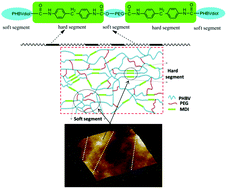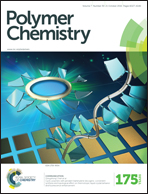A novel biodegradable polyurethane based on poly(3-hydroxybutyrate-co-3-hydroxyvalerate) and poly(ethylene glycol) as promising biomaterials with the improvement of mechanical properties and hemocompatibility
Abstract
A novel block polyurethane was designed and synthesized based on poly(3-hydroxybutyrate-co-3-hydroxyvalerate) (PHBV), 4,4′-diphenylmethanediisocyanate (MDI) and poly(ethylene glycol) (PEG). The obtained polyurethanes were characterized by proton nuclear magnetic resonance (1H NMR), Fourier transform infrared spectroscopy (FTIR), atomic force microscopy (AFM), differential scanning calorimetry (DSC) and wide angle X-ray diffraction (WAXD). Furthermore, the biodegradability of the synthesized polyurethanes was evaluated at 37 °C in phosphate buffer solution (PBS) at pH 7.4. The results showed that these PHBV-based polyurethanes were degradable in PBS, as indicated by weight loss measurements, scanning electron microscopy (SEM) and FTIR. The cytotoxicity of the novel polyurethane was evaluated using the cell counting kit-8 (CCK8) assay in vitro. Preliminary evaluation of hemocompatibility was carried out via the hemolysis test, dynamic blood coagulation time and platelet adhesion. The current work provides a promising approach to prepare nontoxic and biodegradable polyurethanes with excellent mechanical properties and good hemocompatibility. This new material may find potential application in blood vessel tissue engineering.



 Please wait while we load your content...
Please wait while we load your content...